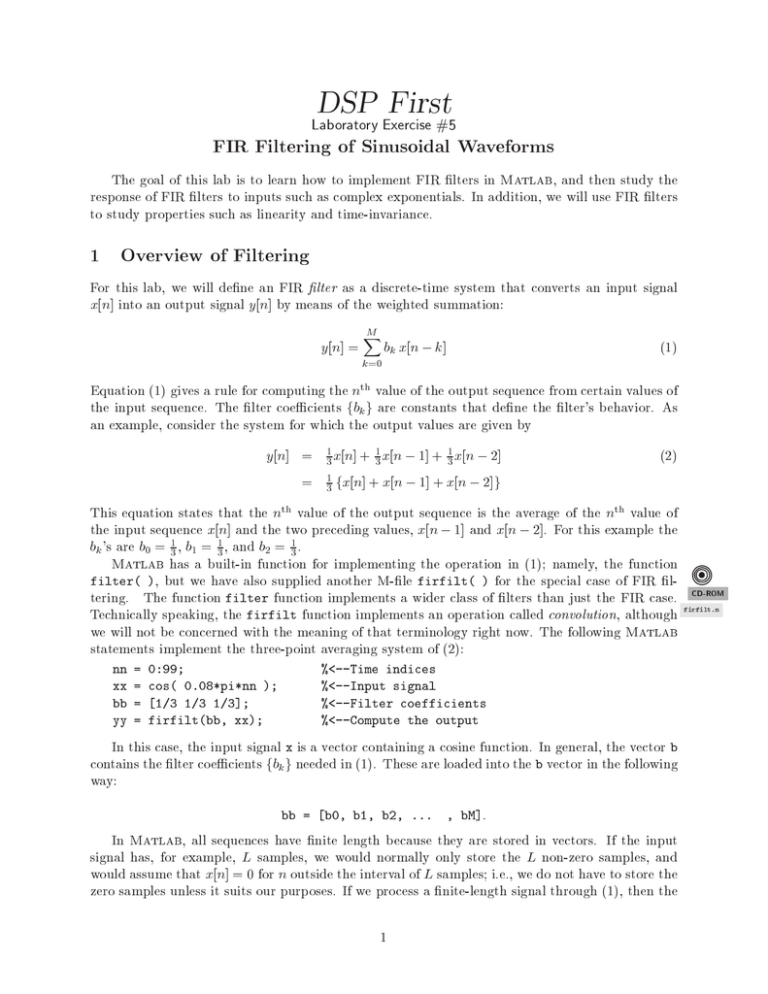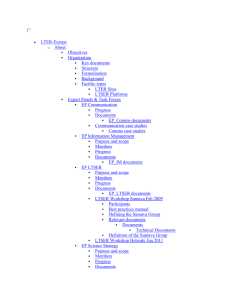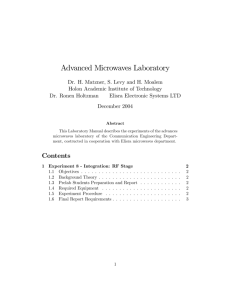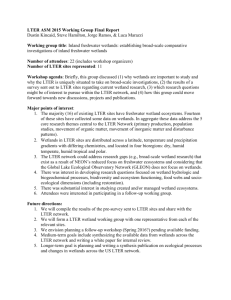FIR Filtering of Sinusoidal Waveforms
advertisement

DSP First
Laboratory Exercise #5
FIR Filtering of Sinusoidal Waveforms
The goal of this lab is to learn how to implement FIR lters in Matlab, and then study the
response of FIR lters to inputs such as complex exponentials. In addition, we will use FIR lters
to study properties such as linearity and time-invariance.
1 Overview of Filtering
For this lab, we will dene an FIR lter as a discrete-time system that converts an input signal
xn] into an output signal yn] by means of the weighted summation:
yn] =
M
X
k=0
bk xn ; k]
(1)
Equation (1) gives a rule for computing the nth value of the output sequence from certain values of
the input sequence. The lter coecients fbk g are constants that dene the lter's behavior. As
an example, consider the system for which the output values are given by
yn] = 31 xn] + 13 xn ; 1] + 13 xn ; 2]
= 31 fxn] + xn ; 1] + xn ; 2]g
(2)
This equation states that the nth value of the output sequence is the average of the nth value of
the input sequence xn] and the two preceding values, xn ; 1] and xn ; 2]. For this example the
bk 's are b0 = 31 , b1 = 13 , and b2 = 13 .
Matlab has a built-in function for implementing the operation in (1) namely, the function
filter( ), but we have also supplied another M-le firfilt( ) for the special case of FIR ltering. The function filter function implements a wider class of lters than just the FIR case.
Technically speaking, the firfilt function implements an operation called convolution, although
we will not be concerned with the meaning of that terminology right now. The following Matlab
statements implement the three-point averaging system of (2):
nn
xx
bb
yy
=
=
=
=
0:99
cos( 0.08*pi*nn )
1/3 1/3 1/3]
firfilt(bb, xx)
%<--Time indices
%<--Input signal
%<--Filter coefficients
%<--Compute the output
In this case, the input signal x is a vector containing a cosine function. In general, the vector b
contains the lter coecients fbk g needed in (1). These are loaded into the b vector in the following
way:
bb = b0, b1, b2, ...
, bM]
:
In Matlab, all sequences have nite length because they are stored in vectors. If the input
signal has, for example, L samples, we would normally only store the L non-zero samples, and
would assume that xn] = 0 for n outside the interval of L samples i.e., we do not have to store the
zero samples unless it suits our purposes. If we process a nite-length signal through (1), then the
1
ht
k
n
CD-ROM
firfilt.m
output sequence yn] will be longer than xn] by M samples. Whenever firfilt(
(1), we will nd that
)
implements
length(y) = length(x)+length(b)-1
In the experiments of this lab, you will use firfilt( ) to implement FIR lters and begin to
understand how the lter coecients dene a digital ltering algorithm. In addition, this lab will
introduce examples to show how a lter reacts to dierent frequency components in the input.
1.1 Frequency Response of FIR Filters
The output or response of a lter for a complex sinusoid input, ej !^ n , depends on the frequency, !^ .
Often a lter is described solely by how it aects dierent frequencies|this is called the frequency
response.
For example, the frequency response of the two-point averaging lter
yn] = 12 xn] + 21 xn ; 1]
can be found by using a general complex exponential as an input and observing the output or
response.
xn] = Aej !^ n + (3)
yn] = 21 Ae(j !^ n + ) + 21 Ae(j !^ (n ; 1) + )
(4)
= Ae(j !^ n + ) 12 1 + e(;j !^ )
(5)
In (5) there are two terms, the original input, and a term which is a function of !^ . This second
term is the frequency response and it is commonly denoted by H (ej !^ ).1
(6)
H (ej!^ ) = 1 1 + e(;j !^ )
2
Once the frequency response, H (ej !^ ), has been determined, the eect of the lter on any complex
exponential may be determined by evaluating H (ej !^ ) at the corresponding frequency. The result
will be a complex number whose phase describes the phase shift of the complex sinusoid and whose
magnitude describes the gain applied to the complex sinusoid.
The frequency response of a general FIR linear time-invariant system is
M
X
H (ej!^ ) = bk e;j!^ k
(7)
k=0
Matlab has a built-in function for computing the frequency response of a discrete-time LTI system.
It is called freqz( ). The following Matlab statements show how to use freqz to compute and
plot the magnitude (absolute value) of the frequency response of a two-point averaging system as
a function of !^ in the range ; !^ :
bb = 1, -1]
%-- Filter Coefficients
ww = -pi:(pi/100):pi
H = freqz(bb, 1, ww)
plot(omega, abs(H))
We will always use capital H for the frequency response. For FIR lters of the form of (1), the
second argument of freqz( , 1, ) must always be equal to 1.
1
The notation H (ej!^ ) is used in place of H(^!) for the frequency response because we will eventually connect this
notation with the z-Transform.
2
2 Warm-up
The instructor verication sheet is included at the end of this lab.
2.1 Frequency Response of the Three-Point Averager
In Chapter 6 we examined lters that average input samples over a certain interval. These lters
are called \running average" lters or \averagers" and they have the following form:
yn] = M 1+ 1
M
X
k=0
xn ; k]
(8)
(a) Show that the frequency response for the three-point running average operator is given by:
H (ej!^ ) = 2 cos3!^ + 1 e;j!^
(9)
(b) Implement (9) directly in Matlab. Use a vector that includes 400 samples between ; and
for !^ . Since the frequency response is a complex-valued quantity, use abs() and angle()
to extract the magnitude and phase of the frequency response for plotting. Plotting the real
and imaginary parts of H (ej !^ ) is not very informative.
(c) The following Matlab statements will compute H (ej !^ ) numerically and plot its magnitude
and phase versus !^ .
bb = 1/3*ones(1,3)
ww = -pi:(pi/200):pi
H = freqz( bb, 1, ww )
subplot(2,1,1)
plot( ww, abs(H) ) %<-- Magnitude
subplot(2,1,2)
plot( ww, angle(H) ) %<-- Phase
xlabel('NORMALIZED FREQUENCY')
The function freqz evaluates the frequency response for all frequencies in the vector ww. It
uses the summation in (7), not the formula in (9). The lter coecients are dened in the
assignment to vector bb. How do your results compare with part (b)?
Instructor Verication (separate page)
3 Lab: FIR Filters
In the following sections we will study how a lter aects sinusoidal inputs, and begin to understand
the performance of the lter as a function of the input frequency. You will see the following:
1. that lters of the form of (1) can modify the amplitude and phase of a cosine wave, but they
do not modify the frequency
2. that for a sum of cosine waves, the system modies each component independently
3. that lters can completely remove one or more components of a sum of cosine waves.
3
3.1 Filtering Cosine Waves
We will be interested in ltering discrete-time sinusoids of the form
for n = 0 1 2 : : : L ; 1
xn] = A cos(^!n + )
(10)
The discrete-time frequency for a discrete-time cosine wave, !^ , always satises 0 !^ . If the
discrete-time sinusoid is produced by sampling a continuous-time cosine, the discrete-time frequency
is !^ = !Ts = 2f=fs , as discussed in Chapter 4 on Sampling.
3.2 First Dierence Filter
Generate L = 50 samples of a discrete-time cosine wave with A = 7, = =3 and !^ = 0:125.
Store this signal in the vector xx, so it can also be used in succeeding parts. Now use firfilt( )
to implement the following lter on the signal xx.
yn] = 5xn] ; 5xn ; 1]
(11)
This is called a rst-dierence lter, but with a gain of ve. In Matlab you must dene the vector
bb needed in firfilt.
(a) Note that yn] and xn] are not the same length. What is the length of the ltered signal,
and why is it that length? (If you need a hint refer to Section 1.)
(b) Plot the rst 50 samples of both waveforms xn] and yn] on the same gure, using subplot.
Use the stem function to make a discrete-time signal plot, but label the x-axis to run over
the range 0 n 49.
(c) Verify the amplitude and phase of xn] directly from its plot in the time domain.
(d) From the plot, observe that with the exception of the rst sample y0], the sequence yn]
seems to be a scaled and shifted cosine wave of the same frequency as the input. Explain
why the rst sample is dierent from the others.
(e) Determine the frequency, amplitude and phase of yn] directly from the plot. Ignore the rst
output point, y0].
(f) Characterize the lter performance at the input frequency by computing the relative amplitude and phase, i.e., the ratio of output to input amplitudes and the dierence of output and
input phases.
(g) In order to compare your measured results to the theory developed in Chapter 6 for this
system, derive the mathematical expression for the output when the input signal is a complex
exponential xn] = ej !^ n . From this formula determine how much the amplitude and phase
should change for xn] which has a frequency of !^ = 0:125.
3.3 Linearity of the Filter
(a) Now multiply the vector xx from Section 3.2 by two to get xa=2*xx. Generate the signal ya
by ltering xa with the rst dierence lter given by ( 11). Repeat the relative amplitude
and phase measurements described in the previous section.
4
(b) Now generate a new input vector xb corresponding to the discrete-time signal
xbn] = 8 cos(0:25n)
and then lter it through the rst dierence operator to get yb n]. Then repeat the relative
amplitude and phase measurements as before. In this case the measurement of phase might
be a bit tricky because there are only a few samples per period. Record how the amplitude,
phase, and frequency of the output yb change compared to the input.
(c) Now form another input signal xc that is the sum of xa and xb. Run xc through the lter
to get yc and then plot yc. Compare yc to a plot of ya + yb. Are they equal ? Explain any
dierences that you observe.
3.4 Time-Invariance of the Filter
Now time-shift the input vector xx by 3 time units to get
xsn] = 7 cos(0:125(n ; 3) + =3)
for n = 0 1 2 3 : : :
and then lter xs n] through the rst dierence operator to get ys n]. Compare ys to yy, the output
when the input is xx. Find a shift of yy (in number of samples) so that it lines up perfectly with
ys.
3.5 Cascading Two Systems
More complicated systems are often made up from simple building blocks. In the system below a
non-linear system (squaring) is cascaded with an FIR lter:
xn]
-
Squarer
( )2
wn] = (xn])2 Discrete-Time
-
Filter
as in (1)
yn]
-
(a) First, assume that the above system is described by the two equations
wn] = (xn])2
(Squarer)
yn] = wn] ; wn ; 1]
(First difference)
Implement this system using Matlab. Use as input the same vector xx as in Section 3.2.
In Matlab the elements of a vector xx can be squared by either the statement xx.*xx, or
xx.^2.
(b) Plot all three waveforms xn], wn], and yn] on the same gure with subplot.
(c) Make a sketch2 of the spectrum of the three signals fxn] wn] yn]g. Recall that the
\squarer" is nonlinear and it is therefore possible for the frequency spectrum of wn] to
contain frequency components not present in xn].
(d) Observe the time-domain output, wn], of the \squarer." Can you \see" the additional
frequencies introduced by the squaring operation?
2
This should, as the term implies, be done by hand. Do not use specgram.
5
(e) Use the linearity results to explain what happens as the signal wn] then passes through the
rst-dierence lter.
Hint: track each frequency component through separately.
(f) Now replace the rst-dierence lter in the above gure with the second-order FIR lter:
y2n] = wn] ; 2 cos(0:25)wn ; 1] + wn ; 2]
(12)
Implement the squaring and ltering to produce a new output y2 n]. Determine which frequencies are present in the output signal. Explain how this new lter is able to remove a
frequency component by calculating y2 n] when wn] = ej 0:25n in (12). In addition, sketch
the spectrum of y2 n].
6
Lab 5
Instructor Verication Sheet
Staple this page to the end of your Lab Report.
Name:
Date:
Part 2.1 Find the frequency response of a 3-point averager:
Veried:
7





